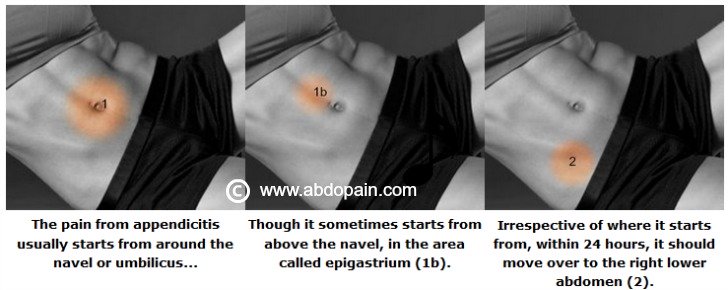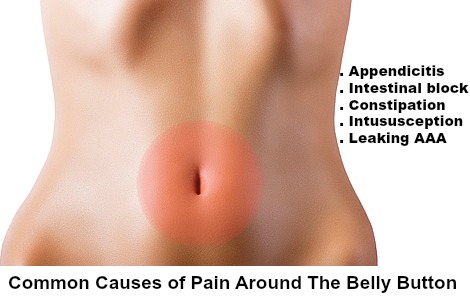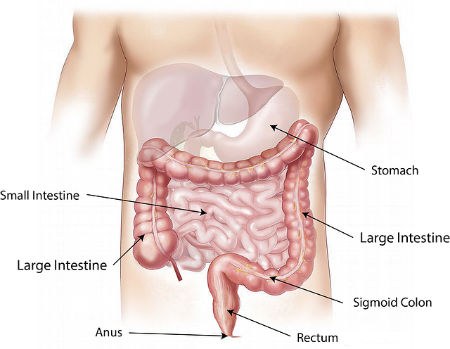Pain Around Belly Button
Causes, Diagnosis And Treatment Of Common Causes Of Pain Around The Belly Button Or Umbilicus
Causes of pain around the belly button in anyone would
include conditions like early stage of appendicitis, bowel or intestinal
obstruction, constipation, and epigastric hernia. If you are experiencing pain
above, on, below or around your belly button or umbilicus, it is important to
find out what might be causing it in good time. You would find common causes of such pain here and what you can do to
overcome it.
What Is The Belly Button or Umbilicus?
The belly button or navel, also called the umbilicus, is the scar at the middle of our abdomen surrounded by a depression or ballooning of the skin immediately around it.
It represents the point at which we were connected directly to our mother through the umbilical cord to the placenta while in the womb.
At birth, the umbilicus is cut and after about 7 days, it dries up and falls off as a stump, leaving a dimple with a permanent scar at the middle.
Infection, obstruction, presence of stone in, or recanalization of the inner stump of the umbilicus or indeed spread of disease to it, including abdominal cancers, could lead to pain in and around the umbilicus or belly button.
Pain around the belly button is defined as any unpleasant dull or sharp sensation within a 2 to 5 cm radius around the navel.
Because the belly button lies in front of our small bowels mainly, conditions involving the small (or large) bowels could also result in pain around the navel or belly button.
Are you suffering with pain around your belly button? The following are the common causes of pain around the belly button, in the belly button or under the belly button.
10 Common Causes of Pain Around Belly Button
1. Early Stage of Acute Appendicitis
This is the most important cause of pain around the belly button or umbilicus that everyone should know about.
 Acute Appendicitis is one of the most important causes of pain around the belly button or umbilicus.
Acute Appendicitis is one of the most important causes of pain around the belly button or umbilicus.Appendicitis is the inflammation of a small finger-like organ in our abdomen called the appendix. It is the most common reason for emergency operation in many parts of the world.
If not diagnosed on time and treated appropriately, death could result.
It is therefore important to recognize the early symptoms of appendicitis.
The symptoms of appendicitis often starts with the development of a dull ache around the navel or umbilicus as depicted in the picture above. The pain could be sharp in some cases. It tends to be mild to moderate initially and could worsen over the course of 6 to 12 hours from when the pain began.
The pain may be associated:
- Bloating of the abdomen
- Loss of appetite
- Mild fever
- Constipation or diarrhoea in children.
The pain around belly button in appendicitis also tends to be made worse by movement. The sufferer tends to prefer coiling in the fetal position or bending over to minimize aggravation of symptoms.
There may be associated vomiting. In acute appendicitis, the vomiting is usually not more than once or twice.
The pain would, usually within 24 hours, then move completely from around the naval or belly button to the right lower abdomen.
Is this what your symptoms look like? See the fully signs and symptoms of appendicitis and what you need to do to help with the diagnosis and treatment of this very common cause of pain around the belly button.
2. Intestinal Obstruction or Blockade
Our small and large bowels, as you know, are tube-like, transmitting food down their lumen while digestion and absorption is taking place.
If for any reason, there is obstruction of flow of food material down this intricate system, it could lead to the experiencing of pain around the umbilicus or belly button accompanied by one or more of the following other symptoms:
- Abdominal bloating and distension
- Nausea or vomiting
- Reduced passing of wind from the anus or inability to empty your bowel
- Severe cramping abdominal pain
Depending on the severity of the obstruction, these symptoms could be so strong that the suffer may be pacing around in pain and vomiting bile stained vomitus.
Such bowel obstruction could result from:
- Intussusception or invagination of a section of the bowel into another part mainly in children
- Tumours
- Adhesion or scar tissue catching on the bowels. If you have pain around your belly button and have had surgery inside your abdomen in the past, it is most likely that your pain is resulting from partial or complete blockage of your bowels from intestinal adhesion.
3. Constipation
Constipation or backup of feces in our bowels can cause cramping abdominal pain around the umbilicus.
- There may be associated nausea, reduced appetite, headaches and passing of lots of winds and hard or infrequent stools.
- Once you are able to open your bowels, the pain would resolve as the other symptoms.
If you suspect that you may be constipated, trial of over the counter laxatives like lactulose or laxaday (movicol) may help.
You should see your healthcare provider should symptoms continue despite use of laxatives.
4. Mesenteric Lymphadenitis
Our bowels are held in place inside our abdomen by a long sheet of tissue called the mesentery. They have glands or lymph nodes inside their wall.
If these glands become infected and swollen like after a bout of cold, the swollen mesentery glands could cause abdominal pain felt around the umbilicus. This inflammation of the glands of the mesentery of the small bowel is what is referred to as mesenteric adenitis or lymphadenitis.
Typically, symptoms of mesenteric adenitis include:
- Mild to moderate central abdominal pain or pain around the umbilicus or belly button of a few days duration
- The pain tends to be fleeting - that is, moves from one spot to the other
- There is usually a positive of history of the child or adult having had a sore throat or cold or viral infection in the preceding 2-3 weeks
- Sufferer would remain healthy looking despite the pain with symptoms sometimes that mimics appendicitis if this pain spreads to the right lower abdomen but there would be no loss of appetite or presence of fever or change in bowel habit
Mesenteric lymphadenitis usually resolve on its own without the need for any treatment. You can read more about this condition here.
5. Leaking Abdominal Aortic Aneurysm (AAA)
The biggest blood vessel that comes from our heart, carrying blood to our abdominal organs and then down to the lower limbs is called the abdominal aorta.
If there is an abnormal ballooning and thinning of the wall of this blood vessel within the abdomen, this is referred to as abdominal aortic aneurysm or triple A.
This usually occur in people after the age of 60 and with family history of this condition or in those who have smoked for many years.
A leak at a weak point of this thinned wall of the aorta could cause blood to run out of the vessel into the open abdomen and irritate the bowels, leading to pain around the umbilicus.
If you suffer with pain around your belly button with associated dizziness, and or shoulder tip pain, or with pain spreading to your lower back, and you are 60 years or older, then it would be important to see your healthcare provider to exclude the possibility of a leaking abdominal aortic aneurysm.
You can read here to see what the symptoms of AAA is and what needs to be done to treat this condition.
6. Herpes Zoster (Shingles) Affecting The Belly Button Area
The skin of the area around the umbilicus is supplied by nerves from the 10th thoracic nerve root.
Shingles or herpes zoster affecting that nerve root can cause pain on the skin around that area.
Initially, there may be no associated rash seen especially in the first day or two of the onset of the pain. You may then notice small blister-like rashes on the side of your waist or around your umbilicus with the pain.
If this is you, then you almost certainly have shingles of the belly button area.
To get best outcome, you must see a healthcare provider and have a firm diagnosis and commencement of treatment within 72 hours of the onset of the pain and or rash.
7. Epigastric Hernia
Epigastric hernia is a condition often difficult to spot but a common cause of pain just above the belly button.
This condition is seen more in the overweight or obese. A small opening occurs in an acquired weakness between where the right and left muscles of the abdomen interwinds at the middle, leading to an out-pouching of fat or abdominal content through that defect.
When that occurs, the suffer may notice a small swelling above the belly button with associated moderate to severe pain there.
Diagnosis is by a thorough examination by the healthcare provider and treatment of epigastric hernia is usually by a simple surgical repair.
8. Umbilical Stone (Umbolith)
Though not so common, some individuals would develop stones inside the recess of the belly button, from dead skin tissue trapped inside it. This could cause the presence of dark hard small lump inside the navel.
There may be associated sharp pain on applying pressure to the navel or during a bout of cough or pain around the belly button after eating or stretching.
Diagnosis is usually by direct vision and identification of the umbolith and treatment is by picking out the stone under direct vision or excision of the umbilical stump.
9. Pilonidal Sinus of The Umbilicus
Are you somewhat hairy and noticed that from time to time you have a foul discharge coming out from inside your belly button or umbilicus?
Do you also feel pain inside the umbilicus?
You may be suffering with what is referred to as pilonidal sinus of the umbilicus or belly button. This is the tunnel that can form inside the skin of the navel from a strand or collection of strands of hairs. The channel could then become infected, with pus formation and discharge, leading to pain inside the umbilicus.
Treatment is by having a small surgery to dissect out and remove the channel or track.
10 . Emotional And Psychological Worries In Children
This is perhaps the most common cause of pain around the belly button. Children between the ages of 2 to 10 would point to their umbilicus or belly button as the point of pain when they are upset or unhappy or indeed when they have many other concerns.
In medicine, it is believed that the closer to the umbilicus a child localises pain, the less likely that it is due to something serious.
While this may be true in most cases, it is important to know that any child's complaint of abdominal pain should be taken seriously and if symptoms persists more than an hour, expert medical attention should be sought.





